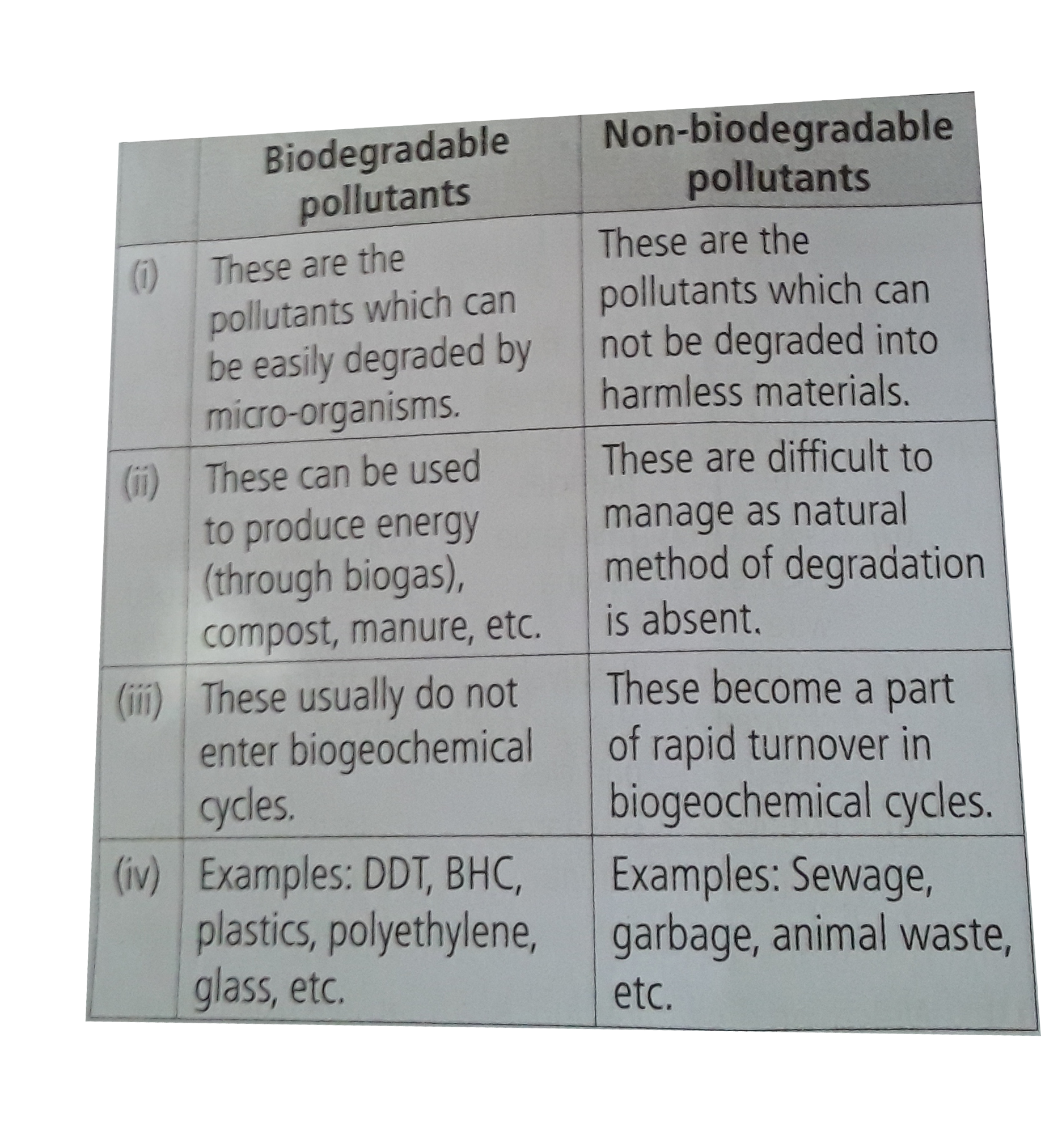Non-biodegradable pollutants are created by
nature
excessive use of resource
humans
natural disasters
Non - biodegradable pollutants have a slow or zero rate of degradation by general biological processess . They include plastics, tin container, heavy metals, radioactive substances, etc. These are created by human activities. Like industrillisation. Biodegradable pollutant are degraded are degraded or disposed quickly by biological processes. Some biodegradable pollutant created by human are papre, house hold waste like peel of vegetables, fruits and sewage.
Topper's Solved these Questions
- BOOK - NCERT EXEMPLAR ENGLISHCHAPTER - ENVIRONMENTAL ISSUES EXERCISE - Very Short Answer Type Questions15videos
ENVIRONMENTAL ISSUES
- BOOK - NCERT EXEMPLAR ENGLISHCHAPTER - ENVIRONMENTAL ISSUES EXERCISE - Short Answer Type Questions11videos
ENVIRONMENTAL ISSUES
- BOOK - NCERT EXEMPLAR ENGLISHCHAPTER - ECOSYSTEMEXERCISE - Long Answer Type Question12videos
ECOSYSTEM
- BOOK - NCERT EXEMPLAR ENGLISHCHAPTER - EVOLUTIONEXERCISE - Long answer type Questions7videos
EVOLUTION
Similar Questions
Knowledge Check
- Question 1 - Select One
Which of the following is a non-biodegradable pollutant ?
ADDTBSewageCPlant leavesDDomestic wastes - Question 2 - Select One
The following table summarises the differences between biodegradable and non-biodegradable pollutants. Pick out the wrong diggerences and select the correct answer.
 A(i) and (iv)B(ii) and (iv)C(iii) and (iv)D(ii), (iii) and (iv)
A(i) and (iv)B(ii) and (iv)C(iii) and (iv)D(ii), (iii) and (iv) - Question 3 - Select One
Given below are four statements each with two blanks. Select the option which correctly fills up the blank in any two statements.
(i) Bhopal gas disaster took place on ___ 1994 and this day is now observed as the ____ day in India to make the anniversary of the Bhopal gas disaster.
(ii) ____ is a biodergradable pollutant while ___ is a non-biodegradable pollutant while ____ is a non-biodegradable pollutant.
(iii) When pollutants are released from a single point it is called ____ pollution, but when it is over a large area, then it is called ____ pollution.
(iv) _____ is the world's most problematic aquatic weed, introduced in India for its lovely flowers, also called as ____.A(i) December 5, National pollution prevention (iv) Parthenium, terror of BengalB(i) December 2, Bhopal gas tragedy (ii) DDT, sewageC(ii) Sewage, DDT (iii) point source, non-point sourceD(iii) line source, fixed source (iv) Eichhornia, tiger of Bengal
Polythene is a non- biodegradable pollutant .
View SolutionIs DDT a biodegradable pollutant ?
View SolutionSort out non-biodegradable and biodegradable pollutants among the following : Mercury salts, sewage, plant leaves, BHC, cadmium salts.
View SolutionRead the following statements carefully.
(i) An electrostatic precipitator removes particulate matter by imposing negative charge on them.
(ii) Catalytic converters convert unburnt hydrocarbons into CO2 and water.
(iii) Peroxyacyl nitrates (PAN) is a secondary pollutant.
(iv) DDT is a non-biodegradable pollutant.
Which of the above statements are incorrect ?View SolutionWhich of the following are true ?
I. Benzene hexachloride is a non- biodegradable pollutants .
II. Anthropogenic air pollutants are natural in origin .
III. Carbon monoxide is a primary air pollutant .
IV. Sulphur dioxide cause brown air effect during traffic congestion in cities.View Solution
